Tags
A lesson plan for all levels – in 10 ½ simple steps
Preparation: Some fascinating recent studies have shown that on average teachers spend about 30 min preparing for each of their classes. Meanwhile other studies (conducted on planet Earth this time) show that such a time allocation may actually be unrealistic. This post is for teachers who live on planet Earth and who know that there are times when one may have to enter a classroom having only had a couple of minutes to prepare (not that such a thing has ever happened to me… 🙂 ). It is in situations like these that one needs a simple, straightforward and easy to implement ‘reusable lesson plan’.
[NB: This lesson plan is based on a presentation I gave some time ago. The slides will help you follow the various steps. To download the slides, click here].
What you will need: To run this lesson properly you need to have a computer, a data projector, speakers and an ordinary internet connection. The students do not need to have any electronic devices. You will need to access a site (Breaking News English – BNE) and a tool (Quizlet). Both of them are extremely easy to use. If I can use them, so can my grandmother.

What is Breaking News English? BNE is a site started by Sean Branville and visited by thousands of teachers every day. Sean takes topical news stories, rewrites them and posts the text along with a large number of activities that a teacher can use immediately. All the tasks are on the same page – along with the key. [NB: The stories come in different levels, carefully graded for language and task difficulty, so this sequence can be used with students at almost any level].
What is Quizlet? Quizlet is a fantastic tool, based on the tried and tested ‘card system’ students used in the past in order to learn vocabulary. The idea is that you prepare a set of (digital) cards that you can then use to revise wherever you are, whenever you want. But the software allows you to do a lot more than the simple recall activity people can do with the traditional version. [NB: Importantly, you can also share your sets, which means that you can send your students the sets you would like them to study and they can share sets with each other].
Step 1: Pre-listening: [To follow the various steps on the BNE site, just click here]. The idea here is to activate your students’ mental schemata. So you choose a few key words from the text and you get students to predict what the text might be about. You then scroll down where it says ‘Before Reading / Listening’ and get them to look at the T/F Qs. It is important that you get students to predict the answers first (which incidentally is a useful exam skill). Generally speaking, having some idea of what is to follow helps students perform better and boosts their confidence.
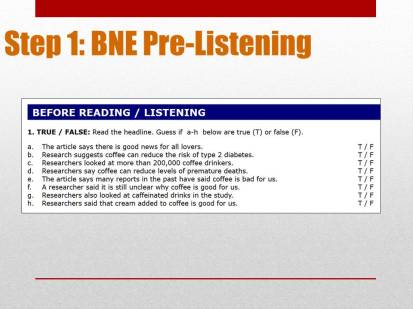
Step 2: BNE – Listening: BNE allows you to listen to a recording of the text. Before that though, you need to give your students a focus task. In this case it is the T/F Qs they have just looked at. Then you play the recording and students can check their predictions. [NB: BNE also has a M/C activity for the listening part – this task may offer extra face validity for some exam classes].

Step 3: BNE – Reading + Noticing: To get students to focus on the text in greater detail, you can then get them to look at the 10 Comprehension Qs (further down). They should be able to answer some of them. Then you can show the class the text for a short time (say 1 min since they have already listened to it) and ask them to answer the remaining Qs as well. But for students to really benefit from the language of the text, they have to focus on it and start ‘noticing’ things (see Lewis 1997). Simply making mental notes is not much good however; they need to put pen to paper. At this point it is crucial to stress two things: i) words on their own are of little use; we need to focus on phrases/collocations instead; ii) instead of looking at unknown words/phrases, it makes more sense to focus on the ones we can understand but would be unable to use.
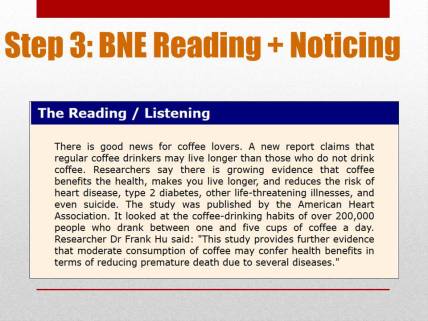
Step 4: Quizlet – Flashcards: Once we have identified what language we would like to keep, we switch to Quizlet and we prepare a set of cards (just click here). Instead of doing it in the traditional way however (word /translation, e.g. ‘cast’/‘ρίχνω’) I have found it is far better to record collocations (e.g. ‘cast’/‘anchor’ or ‘insist on’/‘participating’). In most cases this combination of words is self-explanatory. Then the students work with the cards in the traditional way. They can look at one side and try to recall what is on the other. There is a shuffling option, which means that you do not always look at the cards in the same sequence. You can also mark the cards that you find difficult. The software then brings them up again and again so that you get to study them more.

Step 5: BNE – Gap-filling 1: At this stage we can go back to BNE and do the ‘Gap-Fill’ activity. However, we can make the task a lot more productive by covering the words on the right. Recognising the missing item is one thing – retrieving it is another. As Brown, Roediger & McDaniel point out (2014 – ch. 2) the need for retrieval makes the task more effortful and far more useful for learning purposes. The more effortful the exercise is, the more likely the words are to be retained in long-term memory. [NB: This skipping back and forth between Quizlet and BNE is intentional; switching helps maintain the students’ attention].
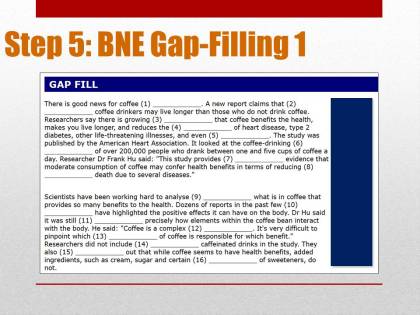
Step 6: Quizlet – Scatter: That done, we can switch back to Quizlet. The ‘Scatter’ game is essentially a matching task. The software presents you with your card entries in random order. You have to match the word on the one side of your cards with that on the other to make the collocation disappear, but there are two little elements that make the task interesting: i) you have to drag the words (as opposed to just linking them) and ii) there is the time element! You can do it in class as a contest between 2 groups – the one with the lowest time wins. [NB: It is important to ask students to read the collocations aloud while they match them, as this helps with retention].
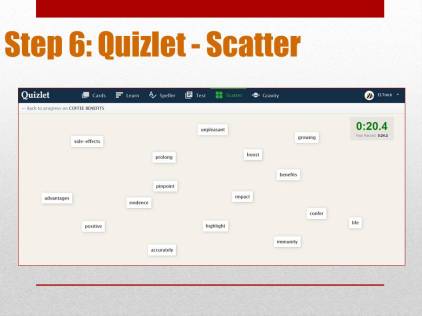
Step 7: BNE – Gap-filling 2: Returning to BNE, students can be asked to do the ‘Listen and fill in the gaps’ task. It is best not to use the listening track. You simply ask students to fill in the gaps from memory – perhaps working in pairs. Crucially, you tell them that they need not worry about recalling the original text; the idea is simply to complete the text so that it makes sense. In this case for instance, we can fill the second gap by writing ‘than those’ or ‘than people who’ or ‘compared to those who’ etc. This is important as it helps students move away from the language of the text and focus on meaning.
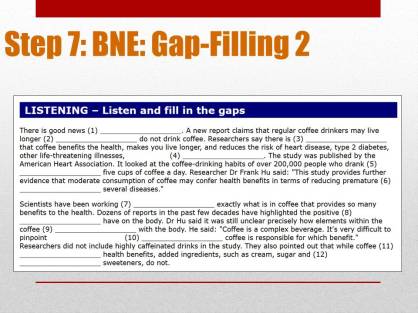
Step 8: Quizlet – Test: Going back to Quizlet, if we click on the ‘Test’ button, the software will automatically prepare a test based on our card set (isn’t technology amazing? 🙂 ) The activities are simple and at the end of the test the students get instant feedback and a grade so they can track their progress. The test can be done in seconds. [NB: The software generates a new test each time, so it makes sense to compare your performance with earlier tries if you want to return to the set after a few days/weeks].
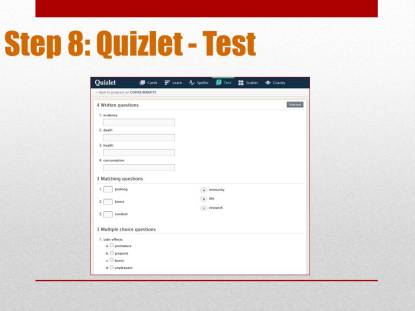
Step 8.5: BNE – Crossword: OK – this is the ‘half- step’. 🙂 Back to BNE. If at this stage students are tired, you can give them a welcome break by clicking on the ‘Crossword’ option. Amazingly, when you do so, the software automatically prepares a crossword puzzle based on words from the text. In my experience students love crosswords and of course the activity does help consolidate the new knowledge and provides new links between the words and the definitions.

Step 9: BNE – Monologue: This is the most demanding (and the most useful) part of the lesson. In pairs, students take it in turns to present the ideas in the text orally to their partner using a basic framework to aid their memory (see the slide below). The point is not for them to reproduce the text verbatim, but rather to convey the general meaning. It is important that we encourage them to expand, amplify and give their own examples. Brown, Roediger & McDaniel (2014 – p. 207) call this strategy ‘Elaboration’; it helps integrate new material into what students already know.
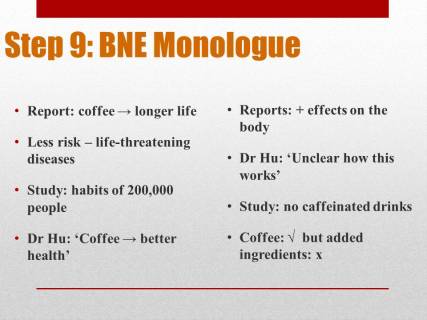
Step 10: Quizlet – Game (Gravity): This can be your students’ reward for all their hard work. They will love this one! J It is a typical arcade game. The idea is that you have to protect the planet from incoming asteroids (without calling on Bruce Willis). Each of the rocks has a word on it and you have to quickly type the other part of the phrase / collocation in order to neutralize the asteroid. You can do it as a whole-class activity on the screen and have the whole class screaming out the phrases – it is huge fun!
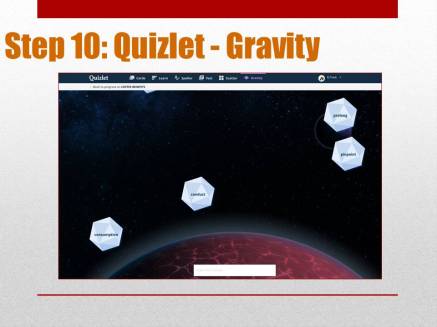
Advantages: There are a number of reasons why this ‘reusable lesson’ is one of my favourites: i) time: it requires minimal preparation (the Quizlet set can even be prepared in class!); ii) progression: the tasks follow a natural sequence (e.g. from receptive to productive skills) iii) speed: it is fast – many of the steps require very little time; iv) variety: the range of tasks means the students get bored; v) challenge: many of the tasks are designed so that students want to do them again and again; vi) levels: this lesson can be used with students of all levels (BNE offers 7); finally (and most importantly) vii) learner independence: learners can use BNE and Quizlet on their own – they are very effective learning strategies.
Last words – Technology is our friend: It is amazing how much effort the judicious use of some simple technological tools can save the usually overburdened teacher – and how much it can help energise the often demotivated learners. But then technology has always been our friend. Ever since the good old days of the Audiolingual method (Ah, those were the days… 🙂 ). The idea was simplicity itself: you insert the tape into the cassette player. You press the play button. You listen. You repeat. You’ve learned the language (as long as you ignore what the second woman is saying…). Just watch this clip. Enjoy. 🙂
References
Brown, P., Roediger, H., McDaniel, M. (2014) Make it Stick: The Science of Successful Learning. Cambridge Massachusetts. Belknap Harvard.
Lewis, M. (1997) Implementing the Lexical Approach. Hove: Language Teaching Publications.
Link: Slideshare: ‘Prep Time – Zero’: http://www.slideshare.net/nickmi1234/preparation-time-zero
Link: Quizlet: Flashcard set: ‘Coffee Benefits’: https://quizlet.com/_1ri2ga
Link: BNE: ‘Coffee’ http://www.breakingnewsenglish.com/1511/151119-coffee.html
![Psychology for Educators [And More] Psychology for Educators [And More]](https://s0.wp.com/wp-content/themes/pub/chateau/images/chateau-default.jpg)
Thanks for sharing this useful material. My collegues will be very glad using it during our lessons.
LikeLike
Glad you like it Elena. I am pleased to say this sequence has always worked well with my students.
LikeLike
Thanks for sharing this useful material, it seems very attractive & interesting😊
LikeLike
Thank you for your kind words Adriana. 🙂
LikeLike